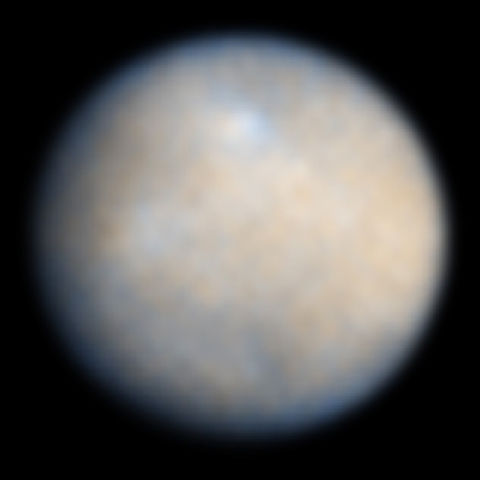 |
This is a file from the Wikimedia Commons. Information from its description page there is shown below.
Commons is a freely licensed media file repository. You can help.
|
Summary
| Description |
English: NASA's Hubble Space Telescope colour image of Ceres, the largest object in the asteroid belt. Astronomers optimized spatial resolution to about 18 km per pixel, enhancing the contrast in these images to bring out features on Ceres' surface, that are both brighter and darker than the average which absorbs 91% of sunlight falling on it. (Original description by NASA) (Earth Distance: 1.64 AU and Angular diameter: 0.798")
Français : Image couleur de Cérès, le plus gros corps de la ceinture d'astéroïdes, prise par le télescope spatial Hubble de la NASA. Les astronomes ont affiné la résolution de l'image à environs 18km par pixel, et ont amélioré le contraste afin de faire ressortir les détails de la surface de Cérès, surface qui absorbe en moyenne 91% de la lumière qu'elle reçoit du soleil. (traduction de la description originale de la Nasa) (Distance à la Terre: 1.64 UA, Diamètre angulaire: 0.798")
|
| Date |
Taken: 2004-01-23. Released 7 September 2005 |
| Source |
image (Cropped from original) from Hubble Space Telescope |
| Author |
NASA, ESA, J. Parker (Southwest Research Institute), P. Thomas (Cornell University), and L. McFadden (University of Maryland, College Park) |
Permission
( Reusing this file) |
Unless otherwise specifically stated, no claim to copyright is being asserted by STScI and it may be freely used as in the public domain in accordance with NASA's contract. [...]
|
Image data cropped from border
- Ceres. January 23, 2004
- Hubble Space Telescope. ACS/HRC
- NASA, ESA, and J. Parker (Southwest Research Institute) STScl-PRC05-27c
Licensing
| Public domainPublic domainfalsefalse |
 |
This file is in the public domain because it was solely created by NASA. NASA copyright policy states that "NASA material is not protected by copyright unless noted". (See Template:PD-USGov, NASA copyright policy page or JPL Image Use Policy.) |
|
|
|
Warnings:
- Use of NASA logos, insignia and emblems are restricted per US law 14 CFR 1221.
- The NASA website hosts a large number of images from the Soviet/ Russian space agency, and other non-American space agencies. These are not necessarily in the public domain.
- Materials based on Hubble Space Telescope data may be copyrighted if they are not explicitly produced by the STScI. See also {{ PD-Hubble}} and {{ Cc-Hubble}}.
- The SOHO (ESA & NASA) joint project implies that all materials created by its probe are copyrighted and require permission for commercial non-educational use.
- Images featured on the Astronomy Picture of the Day (APOD) web site may be copyrighted.
|
File usage
The following pages on Schools Wikipedia link to this image (list may be incomplete):
This file contains additional information, probably added from the digital camera or scanner used to create or digitize it. If the file has been modified from its original state, some details may not fully reflect the modified file.
All five editions of Schools Wikipedia were compiled by SOS Children. SOS Childrens Villages helps more than 2 million people across 133 countries around the world. There are many ways to help with SOS Children's Villages.





